#drip painting
Text
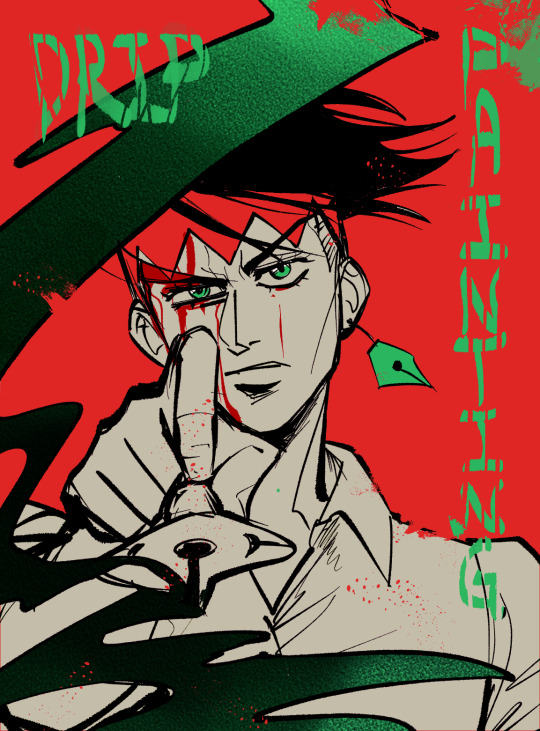
Thus spoke kishibe rohan: drip painting
#my art#jjba#jojo’s bizarre adventure#kishibe rohan#rohan kishibe#thus spoke kishibe rohan#drip painting#kishibe rohan ha ugokanai
73 notes
·
View notes
Photo

Denis de Gloire — “Dripart 2” (acrylic on canvas, 2016)
126 notes
·
View notes
Text

Detail shot of an abstract painting from a personal art journal...
#art #abstractart #abstract #abstractexpressionist #abstractexpressionism #abstractacrylic #acrylicabstract #splatterpainting #splatter #drippainting #contemporaryartist #contemporaryart #contemporarypainting #acrylicpainting #abstractsonfire #flaming_abstracts #artist #karenreiser #paganartist
#art#artist#abstract art#abstract#abstract artist#karen reiser#abstract expressionism#abstract expressionist#abstract acrylic#abstract painting#art journal painting#art journal#splatter painting#splatter#drip painting#contemporary artist
33 notes
·
View notes
Text
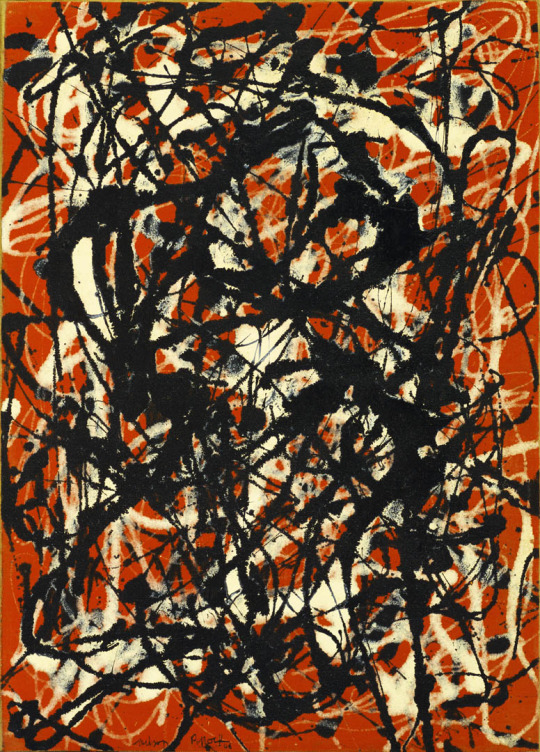
“Free Form”, Jackson Pollock’s first “drip” painting, 1946.
#art#art history#painting#drip painting#jackson pollock#pollock#20th century art#modern art#abstract art#american painter#american art#usa#1900s#free form
392 notes
·
View notes
Photo


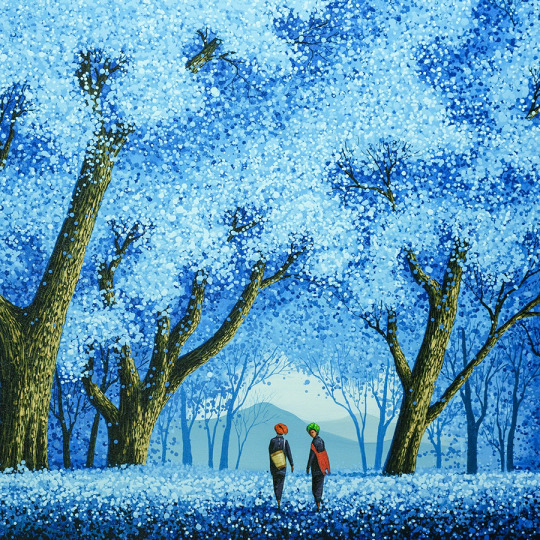



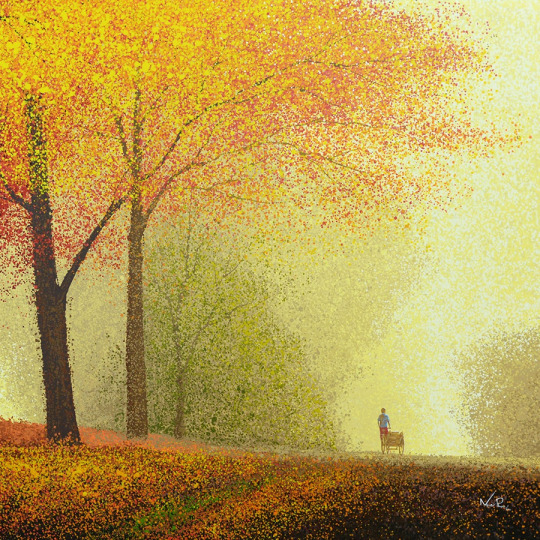
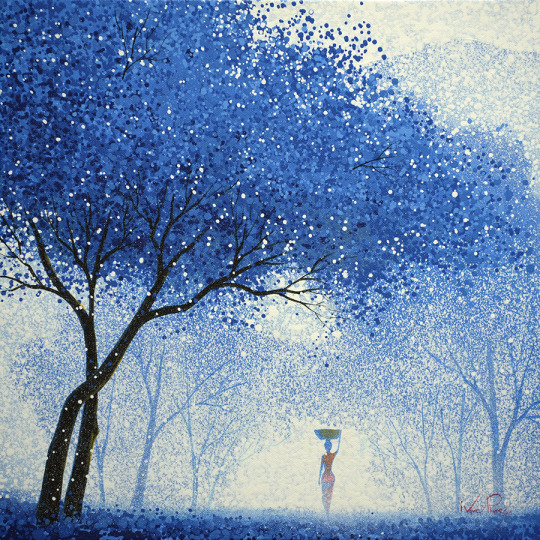
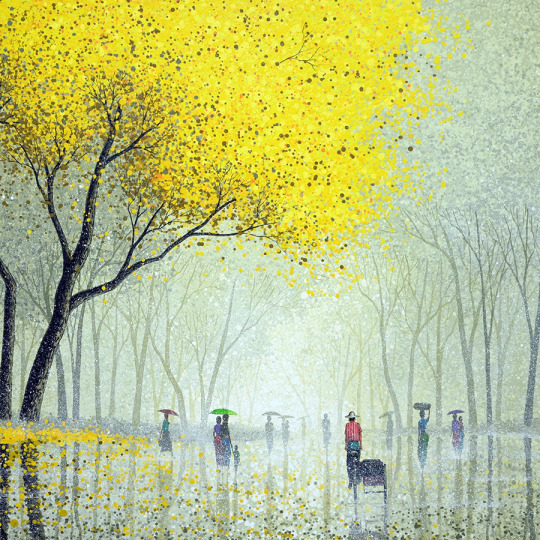
Artist I Like Series
Ngwe Phyoe 1989 - ???? a Myanmarese artist who portrays Myanmar’s landscapes through realistic drip paintings.
#Ngwe Phyoe#21st century art#contemporary art#painting#drip painting#myanmar#myanmarese#male artist#artist I like#art history#art#art inspo#fave#petal talks
42 notes
·
View notes
Text
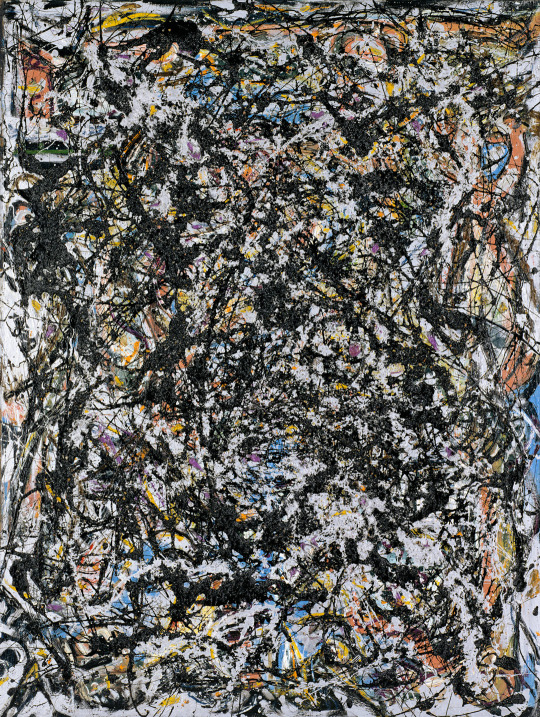
Sea Change
Jackson Pollock
Oil paint and gravel on canvas
57 7/8 x 44 1/8”
New York 1947
#jackson pollock#art#fine art#American art#abstract#abstract art#modern art#modern#abstract expressionist art#de kooning#mark rothko#kandinsky#drip painting#oil painting#oil paint#drip paint#sea change#New York#Seattle#art museum
24 notes
·
View notes
Text



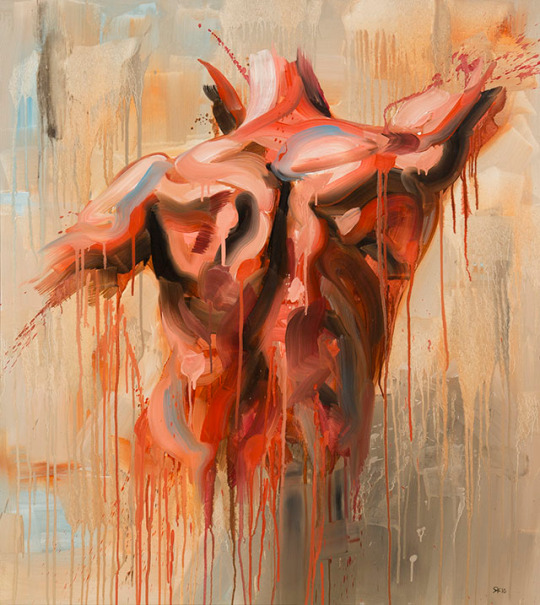
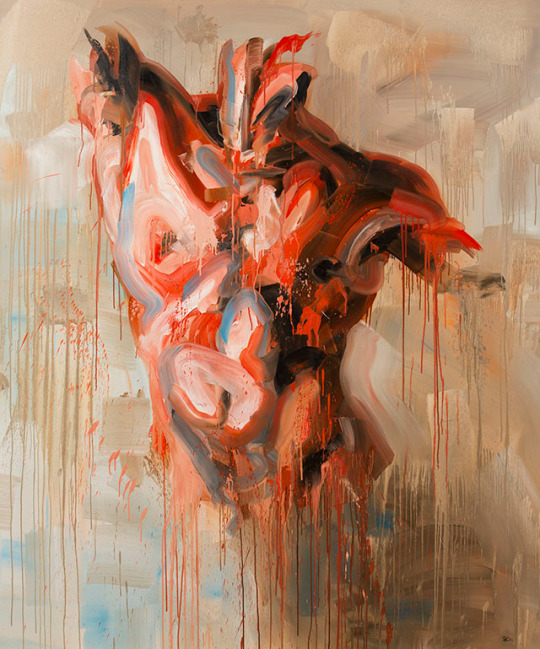
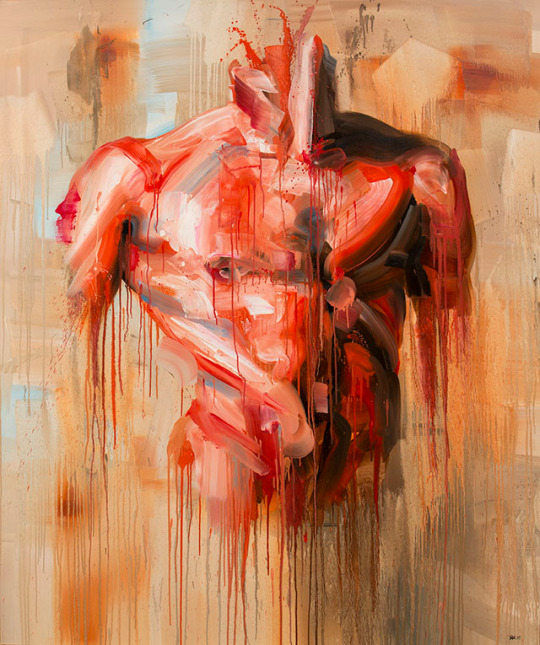
From the Torso series, Salman Khoshroo, 2016, oil on canvas
#art#oil painting#salman khoshroo#figure painting#abstract figure#drip painting#anatomy#torso#figurative#artie showed me one sculpture from this guy and now i'm obsessed
15 notes
·
View notes
Link
The first flush of works is characterised by a primitivist poetry of dreamlike forms floating in enchanted landscapes with a levitational allure that recalls the mystical visions of Marc Chagall, whose own fierce folkloric imagination had been forged by the violence of pogroms. But it isn't long before figurative storytelling gives way to a more ambiguously amorphous cadence of expression that strayed beyond Surrealist impulses to pure abstraction. With no inculcated allegiance to any artistic school or prejudice regarding the appropriateness of materials, Sobel began playing both with what a painting can say and how it can say it. Using unconventional implements such as glass eye-droppers to squirt paint and the strong suck of a vacuum to drag wet splatters into thin gossamers that no traditional brush could spin, she assaulted the surface of canvases laid out on the floor, orchestrating a liquid lyricism of spills, splashes and spits the likes of which had never before been seen.
The result was works such as Milky Way, 1945 – a silent symphony of delicate enamel whorls and surging spatters that Sobel created two years before Pollock would fling his first skirl of paint or began producing his own inchoate cosmic sonatas such as Galaxy (1947). Some creative coincidences can be chalked up to the untraceable synergies of zeitgeist – contemporaneous imaginations incidentally synchronised to the same cultural stimuli. This isn't one of them. Pollock was profoundly influenced by Sobel's work, and history has saved the receipts. Almost as quickly as Sobel had begun to experiment with making images, her son Sol set about attracting attention to her remarkable efforts, reaching out to everyone from Chagall himself to the influential art collector Sidney Janis, who would prove instrumental in establishing the reputations of everyone from Willem de Kooning to Mark Rothko to Pollock.
By 1944, Sobel was well on her way to being a formidable fixture in the New York art scene, debuting that year with a solo show at the Puma Gallery on 57th Street – an exhibition that yielded widespread praise for her works' "astounding sophistication" and "absolutely unrestricted" imagination. Janis (who predicted that Sobel "will probably eventually be known as one of the important surrealist artists in this country"), included her work in a prominent exhibition Abstract and Surrealist Painting in America that toured the country that year.
...
Whatever one's estimation of the relative merits of Sobel's and Pollock's work at this moment in the unfolding narrative of modern art, as history would have it, Pollock would prove to be in the far stronger position to advance the technique of drip painting, whether it was his invention or not. Just as Sobel was gaining traction as a creative force in New York – no small feat for a female artist of her or any generation – her circumstances suddenly changed dramatically, and in ways that effectively removed her from the world of art completely. In 1946, the same year that she opened a solo show at Guggenheim's Art of the Century gallery, her husband Max, moved the family from Brooklyn to Plainfield, New Jersey, in order to be nearer to his costume jewellery enterprise. Unable to drive, Sobel quickly found herself cut off from the ebb and flow of the art scene in which she had only just become an important player.
Compounding that geographic disadvantage was the decision taken the following year by her biggest advocate, Peggy Guggenheim, to relocate to Europe, closing behind her the doors of the Art of the Century gallery – Sobel's principal platform. Adding insult to injury, the onset of an allergy to an ingredient in paint forced Sobel to turn instead to media such as crayons that were less conducive to the drip technique, all but forcing her to abandon the innovation entirely. By 1948, Janet Sobel, who would die in obscurity 20 years later, had effectively vanished from the art world. Though not without a trace. Her enduring genius can still be mapped in the innumerable knots and infinite coils of pigment with which Pollock will proceed to intertwine his more famous canvases – endlessly weaving her spirit into the tangled firmament of art history.
67 notes
·
View notes
Photo

“Full Fathom Five” (1947), Jackson Pollock
“The painting has a life of its own. I try to let it come through.”
#art#I love art#Jackson Pollock#Pollock#artists on tumblr#Tumblr art blogs#abstract art#follow art#modern abstract art#modern art#art quotes#painting#american artists#drip painting#art history
16 notes
·
View notes
Text

Artist:
Jackson Pollock (1912-1956) American 🟡⚫️🟤
16 notes
·
View notes
Text



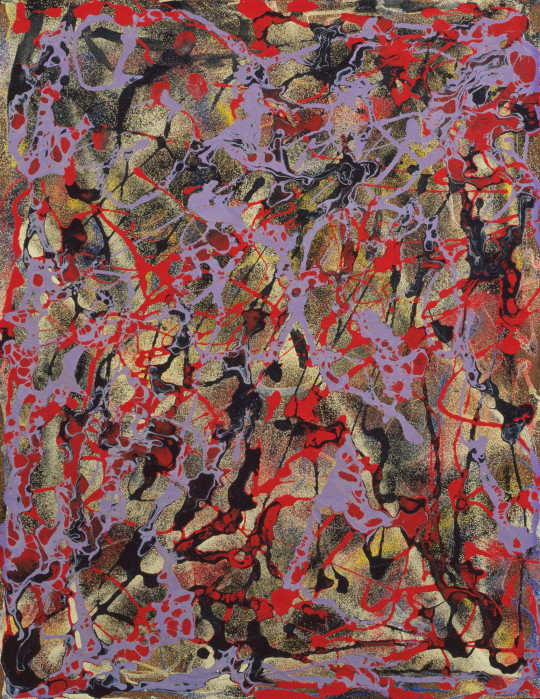


Janet Sobel (May 31, 1893 – 1968) was a Ukrainian-American Abstract Expressionist painter whose career started mid-life, at age forty-five in 1938. Sobel was the first artist to use the drip painting technique that directly influenced Jackson Pollock.[1] She was credited as exhibiting the first instance of all-over painting seen by Clement Greenberg, a notable art critic.
Early life
Janet Sobel was born as Jennie Olechovsky in 1893 in Ukraine. Her father, Baruch Olechovsky,[2] was killed in a Russian pogrom. Sobel along with her mother, Fannie Kinchuk, a midwife,[3] and siblings moved to Ellis Island in New York City in 1908.[2]At sixteen years of age, she married Max Sobel, with whom she had five children.[3]
She was the mother of five children when she began painting in 1937. She produced both non-objective abstractions and figurative artwork.[4] Upon recognizing Sobel's talent, her son helped her artistic development and shared her work with émigré surrealists, Max Ernst, André Breton, as well as John Dewey and Sidney Janis.[5]
12 notes
·
View notes
Photo

Denis de Gloire — Pinks and Roses (acrylic on canvas, 2022)
118 notes
·
View notes
Text


Red and White Splatter on Powder Blue, 8" x 10", abstract acrylic painting on canvas tile, by Karen Reiser
Prints available from Redbubble (@redbubble): https://www.redbubble.com/shop/ap/139372676
#art #abstractart #abstract #abstractexpressionist #abstractexpressionism #abstractacrylic #acrylicabstract #splatterpainting #splatter #drippainting #redbubble #contemporaryartist #contemporaryart #contemporarypainting #acrylicpainting #abstractsonfire #flaming_abstracts #artist #karenreiser #paganartist
#art#artist#abstract art#abstract#abstract artist#karen reiser#abstract expressionism#abstract expressionist#abstract painting#abstract acrylic#acrylic painting#acrylic on paper#redbubble#fine art#splatter painting#splatter#drip painting#contemporary artist#contemporary art#contemporary painting#pagan artist
16 notes
·
View notes
Text

“White Light”, 1954, Jackson Pollock.
#art history#painting#paintings#art#pollock#jackson pollock#modern art#modernism#american modernism#abstract art#drip painting#1950s art#20th century art#abstraction#light
121 notes
·
View notes
Photo
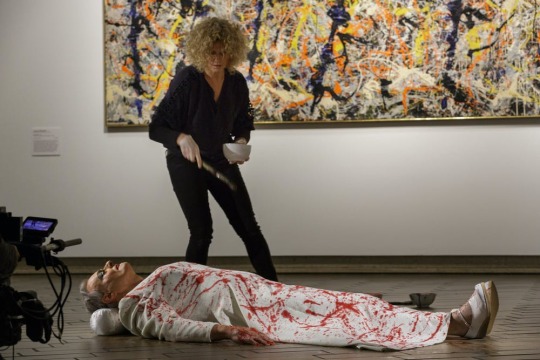
Jackson Pollock the Female - Mike Parr
“On the opening night of his retrospective exhibition, wearing a long white gown, Mike Parr had blood extracted from the veins in his right arm while seated before a crowd. He then lay on the floor of the National Gallery of Australia beneath Pollock’s Blue Poles, before collaborating artist Linda Jefferys painted the blood over Parr’s body in the manner of Pollock’s famous drip painting method.
“He then lay still and silent for 20-30 minutes like a screen or a canvas on which we could project our own unconscious images. This was Parr’s new performance piece, Jackson Pollock the Female.”
38 notes
·
View notes
Text
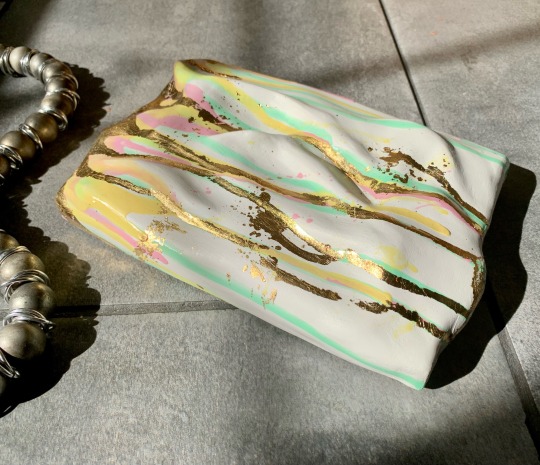
Been playing with gold leaf. Jeez, so damn fiddly! Looked ok in the end. Distressed gold leaf 😆 distressed artist literally covered in bits of gold! Had to hoover it all up, my study looked like tinker bell had visited!
As per usual, this piece is for sale. Check it out
#contemporary art#abstract art#plasterart#gold leaf drip#drip painting#etsyseller#3d art#pastel colours#gold leaf art
2 notes
·
View notes